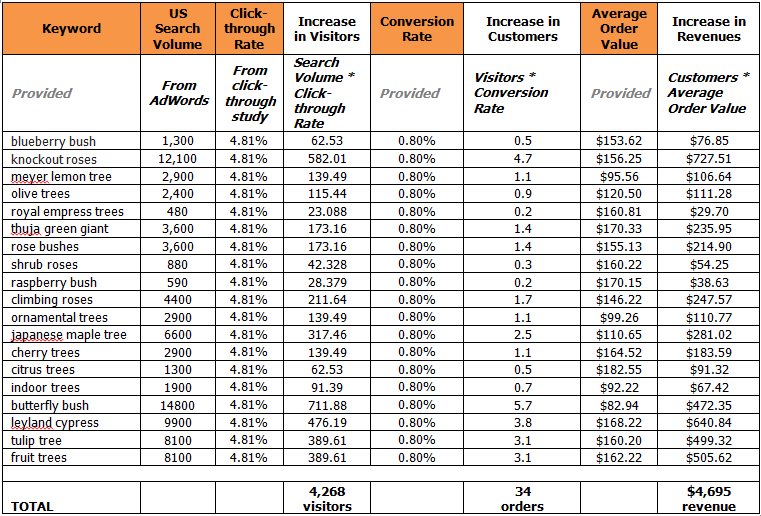Sometimes when I pick up a sales call about SEO, they get it. They know what it can do and they know what it takes.
Many times, they (or their bosses or co-workers or CFOs) don’t.
Their boss told them to make sure to check off the “Yes, this new site is optimized” box, or they know it’s kinda important, or they know that their website isn’t really working that hard for them. Making marketing ROI tangible is hard. Thankfully, I’m not an SEO, I’m a business person.
SHOW ME THE MONEY
Instead of counting sheep, I count the number of times someone has asked me “how much opportunity is there for me to grow sales?” Which makes most SEOs cringe, but as a business person, I need to know this, even if it’s a rough estimate.
Here’s what you need:
- Sampling of priority terms that aren’t ranking well
- Monthly Search Volume from AdWords, exact is my preference
- Click-through rate from your study of choice (I’ve used Slingshot’s and a #4 ranking)
- Conversion rate (the more granular the better)
- AOV (average order value- the more granular the better)
The below chart is a sales funnel that illustrates the relationship between search volume, visitors, orders and revenues.
 A few caveats:
A few caveats:
- I assumed I could reasonably get a #4 ranking. For some industries and products, this might not be possible. Do a quick search- do you see your competitors in these spots? Can you reasonably compete?
This is especially important if your keywords are other brands. Think you’re going to rank #4 for a big brand that isn’t yours? Probably not.
Does your product require lots of consideration or investment (like a retirement home or degree)? Users aren’t going to just go with the top result so click-through and conversion rates will be skewed. This also gets tricky with Authorship or mixed SERPs.
- This projection doesn’t consider that conversion rates that have been true in the past when the site wasn’t ranking optimally may not be steady as rankings climb.
This excludes longer-tail traffic, which after achieving a solid ranking on the root term, should be more easily gained. If you use phrase match for these terms to account for what that longer traffic might be, visits balloon to 18k new visitors, 144 new orders, and incremental revenue of $20k/month. Not all of those longer-tail keywords may be relevant though so it’s better to play it conservative. Reminder that this is the end goal. It’s going to take time and effort to get to these positions.
BLACKMAILING MOM AND DAD
Once upon a time, we had a client who was a subsidiary of a much larger parent company. And to prevent the subsidiary from making mistakes that they’ve read about in the news, this parent company was not quick to approve new strategies. We recommended contests, scholarships, building up relationships with influential content creators, guest posts, product reviews… with no approval. “Legal” usually comes up here as a stalemate.
If the parent company really has never done those things, you might be out of luck but try a search like site:parentcompany.com intitle:"scholarship"
If you find that your parent company has done what you want to do- there’s a way.
KEEPING UP WITH THE JONESES
Just like blackmailing mom and dad, you can also look to competitors to see what is permissible within an industry. This works best in highly regulated industries like finance and pharmaceuticals and when you take this argument to the head of the house. Often a Marketing Manager knows what the boundaries and sometimes those boundaries can’t be broached without some major C-suite muscle.
“Oh, you can’t have a blog? Well your competitor found a way.” <commence blood boiling>
SEEING SEO IN A MARKETING ECOSYSTEM
Much of the time SEO is seen as its own function, its own process, its own budget line item, but the core of SEO is just when you’re doing all your other things really well. If a company is making major investments in their site or content or social media or plain old other types of marketing, there is a benefit to a partner who can tell you how to pivot the things you’re already doing so that they have the greatest impact on another front.
For example, when we came across Household Name Co. with a blog that they updated almost every day, we rejoiced. What we found was a lot of posts that no one engaged with (no links, no shares, no comments). Now, I understand writers hate to have their words dabbled with in the name of SEO, but ask your content team:
“Which of you writes stuff that you don’t want anyone to see?”
Or ask a designer: “Would you like to spend countless hours (and lots of money) creating a site no one can find?”
They key is to make allies, boost the productivity of other channels, acknowledge that those other marketing teams have been doing a damn good job and you just want them to get the most out of their efforts.
For example- congratulate the PR team for getting some great coverage and then show them links they generated too (and tell them what a great effect they had without even knowing it). Built a great asset for the love of your customers? Awesome! Let’s help you find more people who will love it too. Train your client’s blogging team on SEO best practices- it’s not about telling them what to do, it’s about giving them another tool and helping them hone their skills. There is a value to a team that transcends “Vendor” to “Partner” and takes a vested interest in the well-being of your whole company.
And Clients will always go to bat for Partners. They don’t always for Vendors.

